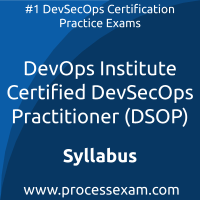 To achieve the professional designation of DevOps Institute DevSecOps Practitioner from the DevOps Institute, candidates must clear the DSOP Exam with the minimum cut-off score. For those who wish to pass the DevOps Institute DevSecOps Practitioner certification exam with good percentage, please take a look at the following reference document detailing what should be included in DevOps Institute DevSecOps Practitioner Exam preparation.
To achieve the professional designation of DevOps Institute DevSecOps Practitioner from the DevOps Institute, candidates must clear the DSOP Exam with the minimum cut-off score. For those who wish to pass the DevOps Institute DevSecOps Practitioner certification exam with good percentage, please take a look at the following reference document detailing what should be included in DevOps Institute DevSecOps Practitioner Exam preparation.
The DevOps Institute DSOP Exam Summary, Sample Question Bank and Practice Exam provide the basis for the real DevOps Institute Certified DevSecOps Practitioner (DSOP) exam. We have designed these resources to help you get ready to take DevOps Institute DevSecOps Practitioner (DSOP) exam. If you have made the decision to become a certified professional, we suggest you take authorized training and prepare with our online premium DevOps Institute DevSecOps Practitioner Practice Exam to achieve the best result.
DevOps Institute DSOP Exam Summary:
| Exam Name | DevOps Institute DevSecOps Practitioner |
| Exam Code | DSOP |
| Exam Fee | USD $240 |
| Exam Duration | 90 Minutes |
| Number of Questions | 40 |
| Passing Score | 65% |
| Format | Multiple Choice Questions |
| Books / Trainings | ONLINE LEARNING |
| Schedule Exam | DevOps Institute |
| Sample Questions | DevOps Institute DevSecOps Practitioner Exam Sample Questions and Answers |
| Practice Exam | DevOps Institute Certified DevSecOps Practitioner (DSOP) Practice Test |
DevOps Institute DevSecOps Practitioner Syllabus Topics:
| Topic | Details |
|---|---|
| Advanced Basics | - Understanding how to succeed, as highlighted by Malcolm Gladwell, depends on knowing not just the basics but understanding why and how those concepts matter. Exploring the fundamentals with Agile and Lean processes, learning about platforms, and knowing who to hire can make all the difference. Equally important to building teams, one must learn how to communicate among teams. |
| Creating DevSecOps Infrastructure | - Solid plans lead to solid infrastructure. Knowing how to transform an organization to cloud-native, lift and shift existing models, and integrate infrastructure as code can mean the difference between success and failure. The most effective parts of infrastructure can rely on securing gateways and end-points through analyzing how customer and internal traffic progresses securely through those areas. |
| Observing DevSecOps Outcomes | - The goal of DevSecOps is not just sooner and safer but establishing outcomes that contribute to organizational value Shifting focus to create value depends on creating observability across all processes, to target metrics and build effective observational tools into the process. Different tools create different views and the observability tools one selects can affect overall outcomes. |
| Applied Metrics | - Everyone starts with basic metrics that can sometimes reach goals, but other times one needs a more concrete understanding of how to build appropriate metrics to succeed. Metrics can apply not just to production but to how one manages people and guides their process to improve success. Selecting the appropriate tools can help accelerate metrics collection and application. |
| Practical 3rd Way Applications | - DevSecOps depends on not just flow and feedback but creating a continuous learning path to always improve. Knowing which areas can be improved relies on effectively collecting quantitative and qualitative data to support improvement efforts. At the same time, external events like hackathons and group sensing sessions can contribute to understanding learning effectiveness. |
| Architecting & Planning for DevSecOps | - Building a DevSecOps plan depends not just on espousing the right words, but having a solid plan on which one can build an effective architecture. Organizational metrics can be confusing and this area clearly builds on enterprise and API metrics across the architecture while including how to integrate effective security metrics. |
| Establishing a Pipeline | - The key part in any good DevSecOps process relies on integrating a DevSecOps pipeline to support the overall value stream. Pipelines must not just be created by people, but then optimized for their success with good DevSecOps fundamentals using WIP across functional and non-functional areas of the pipeline. Effective pipelines contribute to secure repositories and create telemetry to feed back into the overall metric structure. |
| The Future of DevSecOps | - As a cultural process, DevSecOps is here to stay. Keeping in line with DevSecOps means comprehending technical advancements such as quantum computing, bio-design and artificial intelligence. Each of these may contribute to future pipelines, but only if one applies sound innovation practices into continual learning cycles. |
Both DevOps Institute and veterans who’ve earned multiple certifications maintain that the best preparation for a DevOps Institute DSOP professional certification exam is practical experience, hands-on training and practice exam. This is the most effective way to gain in-depth understanding of DevOps Institute DevSecOps Practitioner concepts. When you understand techniques, it helps you retain DevOps Institute DevSecOps Practitioner knowledge and recall that when needed.
